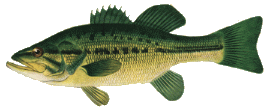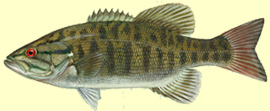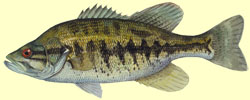| LARGEMOUTH BASS (also known as black bass, green bass & bucketmouth) |
IDENTIFICATION & FEATURES: |
- Jaw extents past the eye
- Broad dark horizontal stripe
- Dark green back blending into lighter green side and belly
|

|
HABITAT:
- Found near weedbeds, logs, stumps & other sunken objects
- Prefers warm water less than 6 m (20 ft.) deep
SPAWNING:
- Largemouth Bass reach maturity in 3-5 years
- Spawns in late spring to early summer
- Eggs hatch in 3-5 days
FOOD:
- aquatic insects, crayfish, frogs & fish
ANGLING:
- Largemouth Bass can be caught along weedbeds & sunken objects
- Takes surface plugs, crankbaits, spinners, spinner baits & flies
- Caught still-fishing with worms, leeches, frogs & crayfish
|
|
| SMALLMOUTH (also known as black bass, brown bass & bronzeback bass) |
IDENTIFICATION & FEATURES: |
- Jaw extends to mid-point of eye
- 8-15 thin vertical bars
- Green to golden-brown back blending into golden sides and a cream-coloured belly
|

|
HABITAT:
- Prefers cool clear water
- Often found near rock shoals and areas with a rocky bottom
SPAWNING:
- Smallmouth Bass reach adulthood at 3-6 years
- Spawns is late spring and early summer
FOOD:
- aquatic insects, crayfish, frogs & fish
ANGLING:
- Takes crank baits, plugs, flies, spinners and spinner baits
- Caught still-fishing with worms, frogs, crayfish, leeches and minnows
|
|
| SPOTTED BASS (also known as Kentucky Spotted Bass, Spotted Black Bass) |
IDENTIFICATION & FEATURES: |
- Irregular lateral stripe is similar to, but more broken than in largemouth bass.
- Jaw does not extend beyond the back margin of the eye when mouth is closed.
- Spots on scales form "rows" of strips on whitish belly area.
|

|
HABITAT:
- Spotted bass inhabit flowing streams and are more tolerant of slow, warm, turbid water than smallmouth. In lakes, spotted bass are found in deeper water. They prefer rocky bottom areas as well as areas with steeply sloping sides.
SPAWNING:
- Spawning takes place in the spring when water temperatures reach 63 to 68 degree F. Males clean out a nest on a gravel or rock bottom, usually near heavy cover. After the eggs are laid and fertilized, males guard the nest in a manner similar to largemouth bass males, remaining with the fry until they are about one month old.
FOOD:
- Crayfish and immature insects make up the bulk of their diet.
- They also eat small fish such as bluegill.
ANGLING:
- Spotted bass are usually caught much deeper than largemouth and are more inclined to school. They are taken frequently from streams, sharing stringers with green sunfish and smallmouth bass.
|
|
|







